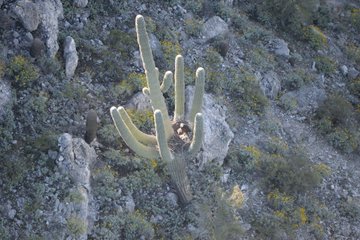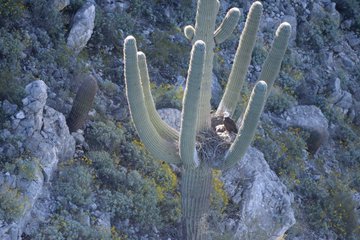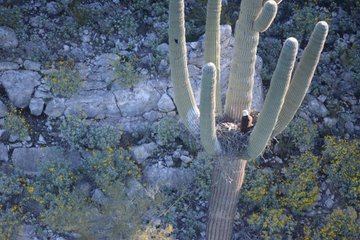/https://public-media.si-cdn.com/filer/0c/f4/0cf416b8-478f-4bbc-87cf-ce8c5c83062a/bald_eagle_haliaeetus_leucocephalus_in_kachemak_bay_alaska.jpg)
This is delightful news. We have seen a steady recovery of all the raptors since the ban on DDT which eliminated agricultural application and DDT accumulation to the top of the food chain. Around Vancouver i have seen eagle flocks in excess of a hundred.
So yes, it makes complete sense that they are now retaking old habitat like those cacti.
Throw in the continual expansion as well of the deer and turkey population band we can expect them everywhere in the USA.
Bald Eagles Found Nesting in Arizona Saguaro Cactus for First Time in Decades
Bald Eagles Found Nesting in Arizona Saguaro Cactus for First Time in Decades
The prickly perch is an exciting sign of success for the birds, which came off the endangered species list in 2007(Andy Morffew / Wikimedia Commons)
SMITHSONIANMAG.COM
APRIL 21, 2020 2:05PM
For the first time in nearly a century, researchers have spotted a saguaro cactus in Arizona playing host to rare, patriotic visitors: a pair of bald eagle parents, nesting with their burgeoning brood.
An undated image, released by the Arizona Game and Fish Department last week, shows the two regal birds fostering their new eaglets—the first-ever photographic documentation of bald eagles nesting in the prickly plant, according to the Associated Press. A similar report last surfaced in 1937, but lacked the photos to prove the sighting.
Bald eagles are infamous for their extravagant, hefty nests, which are the largest of any bird in North America, Eric Pickhartz reports for Wide Open Spaces. Built from branches, these arboreal abodes can reach up to 13 feet in depth and 8 feet in width and can weigh up to 2,000 pounds, making large, sturdy trees a common nesting spot. But bald eagle nests have also been spotted in more peculiar places, including cliffs, rock pinnacles and, of course, the occasional cactus.
The new nest, found near a central Arizona reservoir, was first spied by a member of the public, then confirmed by Kenneth “Tuk” Jacobson, raptor management coordinator for Arizona Game and Fish. “It was absolutely amazing when I got the first report,” Jacobson tells Christopher Howley at Cronkite News. “When we were able to get out there and see [the nest] from the ground … it was quite exciting.”
A few days later, Johnson and his team performed a helicopter survey to gather more intel, and were able to snap several photos of the eagle parents and their eaglets.
How Arizona is this! Our eagle survey team captured this image of a bald eagle family nesting in the arms of a saguaro - a rare sight! In fact, it's the first time an image of eagles nesting in a saguaro has been captured in Arizona.
1,139 people are talking about this
For Johnson, the discovery caps a nearly two-decade search for a cactus-dwelling bald eagle family. With only the 1937 report to buoy them, he and his team had spent years scouring saguaros, which are found exclusively in the Sonoran Desert, to no avail. But the new nest suggests that the birds—once imperiled to the brink of extinction by hunting, habitat destruction, and rampant pesticide use—are now flourishing, Jacobson tells Erin Stone at Arizona Republic.
Since the 1970s, when only a handful of nests dotted Arizona’s desert landscape, the birds have made a remarkable comeback. This pattern has been reflected nationwide, and researchers removed bald eagles from the list of endangered species in 2007.
Still, Jacobson and his colleagues are keeping mum about the bird family’s exact location to ensure their safety. “This is one of those things that is pretty exciting, but the last thing we want to do is draw a lot of attention to it,” he tells Cronkite News. “If we get a lot of people coming out and checking it out, we may end up inadvertently causing problems for their nesting attempts.”
But even with their whereabouts somewhat anonymized, these desert denizens are still a mark of pride for the Grand Canyon state. “When people think of saguaro cactuses, they think of Arizona,” Jacobson tells Arizona Republic. “Then you have a bald eagle in the desert in a saguaro. I don’t know how much more Arizona you can get than that.”




No comments:
Post a Comment